|
  
Click on the pictures to enlarge them then press "Back" to return
the this page
|
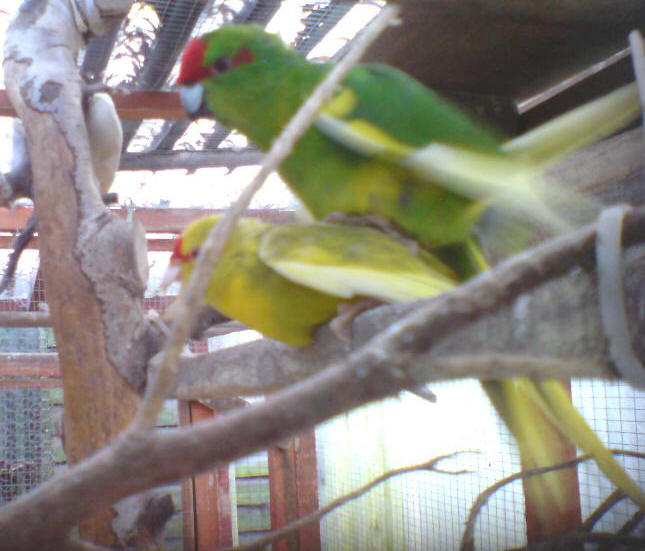
|
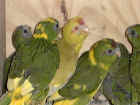 |
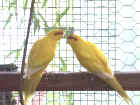 |
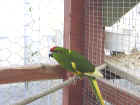 |
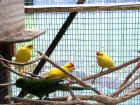 |
|
Kakis in Aviary mating |
Pied, Cinnamon & Normal
Chicks |
Buttercup Pair
|
Pied
Cock
|
Buttercup + Pied Kakarikis
|
|
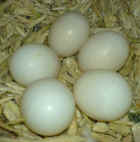 |
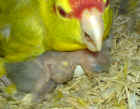 |
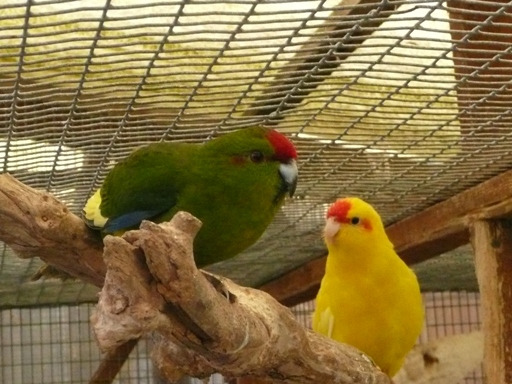 |
  |
 |
|
Kaki Eggs
on an Easibed
base |
"Kraki" with chicks + Eggs waiting to hatch |
Pied
and Buttercup |
2
Pied hens |
Buttercup Cockbird |
|
  |
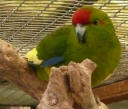 |
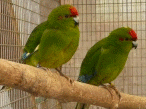 |
 |
 |
|
Cinnamon-Pied+Nrml Pied
this pairing produces Buttercups, Pied and Cinnamon youngsters |
Pied Cockbird |
Pied
Kakis |
Pied Hen + B'cup Cock |
Pied Cock + Cinnamon
Hens |
-
They originate from N. Zealand
(see 4th note below
▼)
-
~ the 2 main colours in
the wild are the red-fronted
-
and the yellow-fronted
(smaller of the 2 and not as common).
-
"Orange-fronted" is a
Hybrid version usually when a Yellow-fronted is mated with a
Red-fronted.
-
A Club Member went on a
Bird watching Trip in New Zealand and the Local Guide told him that the
Red-fronted Kaki actually originated from Australia and the
Yellow-fronted from New Zealand.
-
The name just denotes the
splash of red and/or yellow on the birds top-notch and forehead.
-
The rest of their bodies are
an iridescent dark green with a diffusion of blues in the wing edges.
-
In captivity you find lots of mutations inc. Buttercup
yellow (dark eyes) & Cinnamon (red eyed)
-
+ many variations of Pied and many other
colour variations on the
theme.
SEXING
-
Both sexes look the same -
colour-wise but you can sex them by comparing the general size of the birds
and their heads and beaks.
-
The cock bird is bigger built
and has a slightly bigger head which has a flatter slope to it.
-
Also, the Cocks' beak is
bigger than the hens' - more like a "roman nose".
-
the Hens' beak is much more
petite, esp. when compared beside a cock Birds'.
-
See pictures of a pair of
Buttercup Kakis at top of page, which hopefully help to show the difference.
-
They are virtually unique in that they can "run" up
and down the Aviary Mesh, incl. across the roof mesh, just using their feet
(not using their beaks as most birds do).
-
They love to bathe no matter
what the weather is like (Hot, cold, icy etc.)
-
So, must always have a water
dish big enough for them to bathe in
-
(a
dogs' plastic food bowl or a cat-litter tray is ideal).
-
Otherwise they will use
their drinking water dishes (they probably will anyway).
-
they also use their water
dishes to dunk their food in
-
So better to have a
drinker + water dish/bowl to prevent the drinking water ending up like a
cold soup mush
-
The love fresh air and rain
and will congregate at open mesh rather than shelter behind the covered-in
mesh areas.
-
Even so, they must not be in
draughts and must have plenty of wood shelters + perspex to shelter behind.
If you can't provide a wooden
shed/shelter, then an open fronted wooden box area with a perch or a lip on
the front, can give them somewhere to shelter. 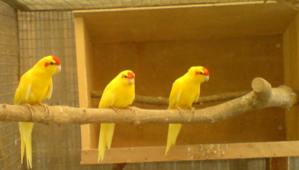
Facing away from prevailing winds.
Wood is warm and insulating.
Whereas perspex, even tho it
does give them shelter from wind and rain, is plastic and gets cold &
icy in winter weather -
It can produce condensation and/or drips when frost
melts, creating a damp, cold atmosphere
^
Go
to Top
DIET
-
They
feed on "Small parakeet mix"
-
Don't
allow them to have too many sunflower seeds.
-
(Sunflower seeds are really NOT healthy, in quantity, for any bird.
-
- they all seem to love
them a bit like kids love sweets and chocs
-
- but they have a very
high fat/oil content, which is not healthy).
-
As per all parakeet types, they must have free access
to Cuttlefish bone, Oystershell and mineralised grit
(for digestion + calcium/mineral content) + Iodised mineral blocks.
-
They
LOVE just about ALL RED BERRIES
-
i.e. Elderberries, Blackberries, Strawberries,
Raspberries, Hawthorn berries, Mountain Ash berries, Cotoneaster Berries,
Pomegranates, Oranges, Grapes etc.
-
They also love :
-
apples, celery, carrot,
sweetcorn, brussel sprouts, Kiwi Fruits, cucumber
-
(most fruit and veg in
fact)
-
+ Eggfood, wholemeal
bread and all the wild foods mentioned above.
-
They also love to chew
Willow and Eucalyptus
branches and leaves.
They are a delight to feed,
as they seem to relish just about anything you give them. -
Unlike a lot of other
parrot-like birds that can be picky & choosy.
-
MEALWORMS/shredded
chicken are beneficial for extra Protein at Breeding Time.
-
They can use their feet to
hold their food to eat it - more like a parrot.
-
Thy also hold twigs in the
their feet to chew on.
-
They can be very wasteful with
their food.
-
They use their feet to scatter
seed out of their feed dishes until they find the seeds they want - usually
the Sunflower!
-
Kaki's have a quiet
inoffensive call, are very friendly and rarely bite.
-
They are very active most of
the time and therefore are unsuitable as a Cage Bird as they really need a
spacious Aviary.
-
They are not as long-lived (8
- 10+ years) as a lot of other parakeets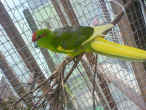
-
They definitely
need
Worming regularly
as they spend a lot of their time scavenging on
the Aviary Floor.
-
(A personal observation is that when they really need worming
they tend to look as if they have gone into a soft moult and look almost
ragged feather-wise
CLICK picture > >
- a good worming seems to sort them - but takes time - so prevention is
better than cure!
"Panomec" (Ivermectin-based) spot-on the back of the neck
is my wormer
of choice for this condition.
BREEDING
It's
better to just have one pair per Aviary for breeding
-
but if they have been
living en-colony prior to putting up the Nest boxes
-
and have
ALL
got on well or grown-up together.
-
you may be able to breed more than one pair per Aviary,
-
So long as the Aviary is
spacious enough
-
You must have more nest
boxes than pairs
-
and they are all the same height and design.
(see info. on
Nestboxes)
-
CLUTCH : They lay
between 5 - 7+ eggs per clutch.
-
INCUBATION
:
19 - 21 days
(may be slightly longer, if they haven't started
to sit until after the first 2 - 3 eggs are laid.
(25 days is not
unheard of).
CLOSE RING :
approx: 11 - 13 days
RING Size:
M
-
They can lay 2 - 4 clutches
per year but really, if they have reared 2 good-sized clutches then the nest
box should be removed once the 2nd clutch have fully fledged, to prevent
them going to nest for a 3rd clutch.
-
Over-breeding is BAD for the
hens' health.
-
They seem to want to breed at
any and all times of the year - esp thru the winter months!!
-
- obviously, depending on how
fit they are and the type of Aviary/ accommodation they are in.
-
The Hen does all the
incubating and the cockbird feeds her in the nest and often sits outside the
nest box
"on guard".
-
Newly-hatched chicks have a
covering of grey down.
-
This helps keep them warm if
they hatch during cooler months.
-
Unlike a lot of other parakeet
chicks (i.e. budgies) that are "born" naked.
-
The chicks can be seen, in the
Nestbox, lying on their backs being fed by the hen.
-
Chicks eyes tend to open
approx 10 days.
-
The Chicks seem slow to
feather & mature (approx 35+ days to feather-up) compared to smaller
parakeets.
-
They don't come out of the
Nest box until well past 45 days.
-
Once they have fledged, they
often go back in and out of the Nest box again during both day and
night
-
They are a quiet inoffensive
Breed, so they work well in a mixed Aviary.
-
So long as there are no big
bully parrot-like birds in the same Aviary.
-
Lovebirds and Kakis tend not
to mix well
-
They also can be prone to
Heart attacks
(Heart-racing syndrone) if put under severe
stress.
|